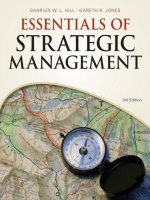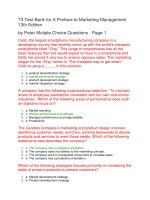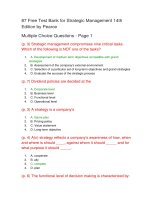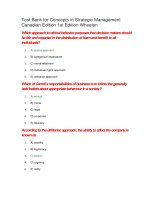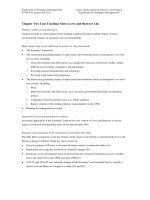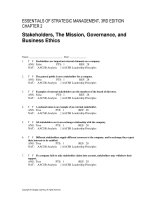Fred r david – strategic management, 13th edition ch01
Bạn đang xem bản rút gọn của tài liệu. Xem và tải ngay bản đầy đủ của tài liệu tại đây (106.96 KB, 39 trang )
Exam
Name___________________________________
TRUE/FALSE. Write 'T' if the statement is true and 'F' if the statement is false.
1)
The underpinnings of strategic management hinge on managers gaining an understanding of competitors,
markets, prices, suppliers, distributors, governments, creditors, shareholders and customers worldwide.
1)
_______
2)
The purpose of strategic management is optimizing for tomorrow the trends of today.
2)
_______
3)
Strategic planning has been cast aside by corporate America since the early 1990s.
3)
_______
4)
Resource allocation is included in strategy-formulation activities.
4)
_______
5)
The terms strategic management and strategy implementation are synonymous.
5)
_______
6)
A vision statement is, in essence, a company's game plan.
6)
_______
7)
Strategy implementation is often considered to be the most difficult stage in the strategic-management
process, because it requires personal discipline, commitment and sacrifice.
7)
_______
8)
The final stage in strategic management is strategy implementation.
8)
_______
9)
In a large diversified organization, strategy formulation, implementation and evaluation activities occur at
three hierarchical levels corporate, divisional and functional.
9)
_______
10)
One of the fundamental strategy evaluation activities is to review the external and internal factors which
are the bases for current strategies.
10)
______
11)
A way to describe the strategic-management process is as an objective, logical, systematic approach for
making major decisions in an organization.
11)
______
12)
Strategic-management process is an attempt to organize qualitative and quantitative information in a way
that allows effective decisions to be made under conditions of uncertainty.
12)
______
13)
Analytical and intuitive thinking should complement each other.
13)
______
14)
According to Albert Einstein, knowledge is far more important than intuition.
14)
______
15)
Management by intuition can be defined as operating from the "I've-already-made-up-my-mind-don'tbother- me-with-the-facts " mode.
15)
______
16)
By monitoring external events, companies should be able to identify when change is required.
16)
______
17)
In 2007, Toyota surpassed General Motors as the world's top producer of cars.
17)
______
18)
As of 2010, the largest company in the world was ExxonMobil.
18)
______
19)
Anything a firm does especially well compared to rival firms could be considered a competitive advantage.
19)
______
20)
Once a firm acquires a competitive advantage, they are usually able to sustain it for an extended period of
time.
20)
______
21)
Newspaper companies in the United States provide a good example of how a company can sustain a
competitive advantage over the long term.
21)
______
22)
Although the Internet has increased in popularity, it has actually led to increases in company expenses.
22)
______
23)
Consumer e-commerce is five times greater than business-to-business e-commerce.
23)
______
24)
Currently, online shopping accounts for almost 15 percent of all shopping.
24)
______
25)
In 2006, customers spent more money online for clothes than they did on computers.
25)
______
26)
In order for a firm to achieve sustained competitive advantage, a firm must continually adapt to changes in
external trends and events and effectively formulate, implement, and evaluate strategies that capitalize
upon those factors.
26)
______
27)
Strategists are usually found in higher levels of management and have considerable authority for decisionmaking in the firm.
27)
______
28)
The middle manager is the most visible and critical strategic manager.
28)
______
29)
All strategists have similar attitudes, values, ethics and concerns for social responsibility.
29)
______
30)
A vision statement answers the question, "What is our business?," whereas a mission statement answers,
"What do we want to become?"
30)
______
31)
In the last five years, the position of chief strategy officer (CSO) has diminished in comparison to other top
management ranks of many organizations.
31)
______
32)
A clear mission statement describes the values and priorities of an organization.
32)
______
33)
Strengths and weaknesses are determined relative to competitors.
33)
______
34)
In a multidivisional firm, objectives should be established for the overall company and not for each
division.
34)
______
35)
Objectives should be measurable, quantitative, challenging, realistic, consistent and prioritized.
35)
______
36)
Annual objectives are long-term milestones that organizations must achieve to reach short-term
objectives.
36)
______
37)
Annual objectives are especially important in strategy formulation.
37)
______
38)
According to research, a healthier workforce can more effectively and efficiently implement strategies.
38)
______
39)
Identifying an organization's existing vision, mission, objectives and strategies is the final step for the
strategic management process.
39)
______
40)
Once an effective strategy is designed, modifications are rarely required.
40)
______
41)
Application of the strategic-management process is typically more formal in larger, well-established
organizations.
41)
______
42)
Understanding is the most important benefit of strategic management, followed by commitment.
42)
______
43)
The changes that occurred at Disney after Robert Iger took over as CEO exemplify how more and more
organizations are centralizing the strategic-management process.
43)
______
44)
Firms which have planning systems that more closely resemble strategic-management theory generally
exhibit superior long-term financial performance relative to their industry.
44)
______
45)
Low-performing firms typically underestimate their competitor's strengths and overestimate their own
strengths.
45)
______
46)
According to Greenley, strategic management provides a cooperative, integrated and enthusiastic
approach to tackling problems and opportunities.
46)
______
47)
The poor reward structure is one reason managers do not engage in strategic planning.
47)
______
48)
Crises and fires in an organization allow managers the training and time for effective strategic planning.
48)
______
49)
One pitfall which managers should avoid in strategic planning is top managers making many intuitive
decisions that conflict with the formal plan.
49)
______
50)
Managers must be very formal in strategic planning because formality induces flexibility and creativity.
50)
______
51)
An integral part of strategy implementation must be to evaluate the quality of the strategic management
process.
51)
______
52)
Strategic management must be a self-reflective learning process that familiarizes managers and
employees in the organization with key strategic issues and with feasible alternatives for resolving those
issues.
52)
______
53)
Today, managers and employees can be found personally liable if they ignore, conceal, or disregard a
pollution problem.
53)
______
54)
Merely having a code of ethics is not sufficient to ensure ethical business behavior.
54)
______
55)
An integral part of the responsibility of all managers is to provide ethical leadership by constant example
and demonstration.
55)
______
56)
In most situations, business strategy is very different than military strategy.
56)
______
57)
International operations can be as simple as exporting a product to a single foreign country.
57)
______
58)
One risk in international operations is that nationalistic factions could seize the operations.
58)
______
59)
All organizations have a strategy from their inception, even if the strategy is informal, unstructured, and
sporadic.
59)
______
60)
Nonprofit organizations have less need for strategic management because they are not interested in
making a profit.
60)
______
61)
Firms can be more proactive with strategic management.
61)
______
MULTIPLE CHOICE. Choose the one alternative that best completes the statement or answers
the question.
62)
Identify a theme that has become a more important strategic issue due to global warming, bioterrorism,
and increased pollution.
62)
______
A)
Monitoring employees
B)
Measuring performance
C)
External environment
D)
Internal stakeholders
E)
Internal environment
63)
What can be defined as the art and science of formulating, implementing and evaluating cross-functional
decisions that enable an organization to achieve its objectives?
63)
______
A)
Strategic management
B)
Strategy evaluation
C)
Strategy formulation
D)
Strategic leading
E)
Strategy implementation
64)
________ is used to refer to strategic formulation, implementation and evaluation, with ________ referring
only to strategic formulation.
64)
______
A)
Strategic management; strategic processing
B)
Strategic planning; strategic management
C)
Strategic implementation; strategic focus
D)
Strategic planning; strategic processing
E)
Strategic management; strategic planning
65)
During which stage of strategic management is a firm's specific internal strengths and weaknesses
determined?
65)
______
A)
Evaluation
B)
Formulation
C)
Goal-setting
D)
Implementation
E)
Feedback
66)
An important activity in ________ is taking corrective action.
66)
______
A)
strategy leadership
B)
strategy evaluation
C)
strategy implementation
D)
strategy formulation
E)
all of the above
67)
What step in the strategic development process involves mobilizing employees and managers to put
strategies into action?
67)
______
A)
Strategic advantage
B)
Strategy evaluation
C)
Competitive advantage
D)
Formulating strategy
E)
Implementing strategy
68)
What types of skills are especially critical for successful strategy implementation?
68)
______
A)
Technical
B)
Thinking
C)
Marketing
D)
Interpersonal
E)
Conceptual
69)
Which phase of strategic management is called the action phase?
69)
______
A)
Strategy implementation
B)
Allocating resources
C)
Measuring performance
D)
Strategy formulation
E)
Strategy evaluation
70)
________ is not a strategy-implementation activity.
70)
______
A)
Taking corrective actions
B)
Establishing annual objectives
C)
Allocating resources
D)
Motivating employees
E)
Devising policies
71)
Strategy evaluation is necessary because
71)
______
A)
competitors change their strategies.
B)
firms have limited resources.
C)
the SEC requires strategy evaluation.
D)
the IRS requires strategy evaluation.
E)
internal and external factors are constantly changing.
72)
Which statement best describes the role of intuition in management?
72)
______
A)
It represents a minor factor in decision-making integrated with analysis.
B)
It represents the marginal factor in decision-making.
C)
It should be coupled with analysis in decision-making.
D)
It is better than analysis in decision-making.
E)
It is management by ignorance.
73)
________ and ________ are external forces transforming business and society today.
73)
______
A)
E-commerce; globalization
B)
E-commerce; strategy
C)
Stakeholders; strategy
D)
Corporate culture; stakeholders
E)
Strategy; globalization
74)
Anything that a firm does especially well compared to rival firms is referred to as
74)
______
A)
competitive advantage.
B)
opportunity cost.
C)
comparative advantage.
D)
an external opportunity.
E)
sustainable advantage.
75)
Who is the world's top producer of cars?
75)
______
A)
Hyundai
B)
Ford
C)
General Motors
D)
Honda
Toyota
E)
76)
What percent of total sales are estimated to be completed online by 2016?
76)
______
A)
20 percent
B)
60 percent
C)
85 percent
D)
7 percent
E)
15 percent
77)
The top three online apparel retailers in 2010, using a measure of fans accross all major social media
platforms, were
77)
______
A)
Gap, Zappos, and L.L. Bean.
B)
Zappos, ASOS, and TopShop.
C)
Sears, Victoria's Secret, and ASOS.
D)
Wal-Mart, TopShop, and Sears.
E)
L.L. Bean, Zappos, and Victoria's Secret.
78)
The trends in newspaper circulation in the United States provide support for which statement?
78)
______
A)
Several firms can have similar competitive advantages.
B)
Sustainable competitive advantage is easy to maintain.
C)
Some products are relatively immune to changes in the external environment.
D)
Most competitive advantages are hard to sustain.
E)
Competition is generally good for companies and consumers.
79)
The one factor that has most significantly impacted the nature and core of buying and selling in nearly all
industries has been
79)
______
A)
the government.
B)
political borders.
C)
corporate greed.
D)
customer and employee focus.
E)
the Internet.
80)
Which individuals are most responsible for the success and failure of an organization?
80)
______
A)
Human resource managers
B)
Strategists
C)
Stakeholders
D)
Personnel directors
E)
Financial planners
81)
The first step in strategic planning is generally
81)
______
A)
making a profit.
B)
establishing goals and objectives.
C)
developing a vision statement.
D)
determining opportunities and threats.
E)
developing a mission statement.
82)
What is the correct term for the enduring statements of purpose that distinguish one business from others
that are similar?
82)
______
A)
Rules
B)
Policies
C)
Mission statements
D)
Objectives
E)
Employee conduct guidelines
83)
The largest company in the world is
83)
______
A)
Ford Motor Company.
B)
ING Group.
C)
Honda Motor.
D)
Wal-Mart.
E)
Royal Dutch/Shell Group.
84)
Usually, external opportunities and threats are
84)
______
A)
key functions in strategy exploitation.
B)
uncontrollable by a single organization.
C)
key functions in strategy implementation.
D)
controlled by governments.
E)
not as important as internal strengths and weaknesses.
85)
Specific results an organization seeks to achieve in pursuing its basic mission are
85)
______
A)
mission.
B)
strategies.
C)
objectives.
D)
rules.
E)
policies.
86)
Internal ________ are activities in an organization that are performed especially well.
86)
______
A)
strengths
B)
opportunities
C)
management
D)
factors
E)
competencies
87)
What are the means by which long-term objectives will be achieved?
87)
______
A)
Opportunities
B)
Policies
C)
Strengths
D)
Weaknesses
E)
Strategies
88)
Long-term objectives should be all of the following except
88)
______
A)
challenging.
B)
measurable.
C)
continually changing.
D)
reasonable.
E)
consistent.
89)
________ can best be described as short-term in nature.
89)
______
A)
Management
B)
Tenure
C)
Mission statements
D)
Strategies
E)
Annual objectives
90)
In which phase of strategic management are annual objectives especially important?
90)
______
A)
Control
B)
Management
C)
Evaluation
D)
Implementation
E)
Formulation
91)
Which of the following are guides to decision making?
91)
______
A)
Laws
B)
Rules
C)
Goals
D)
Policies
E)
Procedures
92)
The strategic-management process
92)
______
A)
is a continuous process.
B)
occurs once a year.
C)
applies mostly to small businesses.
D)
applies mostly to companies with sales greater than $100 million.
E)
is a sequential process.
93)
Which of the following is not included in the strategic management model?
93)
______
A)
Measuring and evaluating performance.
B)
Developing mission and vision statements.
C)
Establishing long-term objectives.
D)
Implementing strategies.
E)
Performing internal research to identify customers.
94)
Strategic management enables an organization to ________, instead of companies just responding to
threats in their business environment.
94)
______
A)
be proactive
B)
foresee into the future
C)
determine when the threat will subside
D)
avoid the threats
E)
defeat their competitors
95)
The act of strengthening employees' sense of effectiveness by encouraging and rewarding them to
participate in decision-making and to exercise initiative and imagination is referred to as
95)
______
A)
empowerment.
B)
delegation.
C)
transformation.
D)
proaction.
E)
authoritarianism.
96)
How do line managers become "owners" of the strategy?
96)
______
A)
By becoming a shareholder of the firm
B)
By gathering information about competitors
C)
By attending top manager meetings
D)
By buying off top managers
E)
By involvement in the strategic-management process
97)
The changes that occurred when Robert Iger became CEO at Disney demonstrate which current trend in
organizations?
97)
______
A)
Increased structuring of strategic management
B)
Increased emphasis on strategic planning
C)
Increased decentralizing of strategic management
D)
Increased formalization of the strategic management process
E)
Increased central planning of the strategic management process
98)
According to research, organizations using strategic management are ________ than those that do not.
98)
______
A)
less profitable
B)
less static
C)
more complex
D)
less complex
E)
more profitable
99)
Which of the following is not one of the benefits of strategic management described by Greenley?
99)
______
A)
It maximizes the effects of adverse conditions and changes.
B)
It provides an objective view of management problems.
C)
It encourages a favorable attitude toward change.
D)
It gives a degree of discipline and formality to the management of a business.
E)
It creates a framework for internal communication among personnel.
100)
Which of the following is not a reason given for poor or no strategic planning in organizations?
100)
_____
A)
Poor reward structure
B)
Fire-fighting
C)
Being content with success
D)
Wasting time
E)
Trust of management
101)
All of these are pitfalls an organization should avoid in strategic planning except
101)
_____
A)
using strategic planning to gain control over decisions and resources.
B)
being so formal in planning that flexibility and creativity are stifled.
C)
too hastily moving from mission development to strategy formulation.
D)
using plans as a standard for measuring performance.
E)
failing to involve key employees in all phases of planning.
102)
Which of the following is not a pitfall an organization should avoid in strategic planning?
102)
_____
A)
Failing to communicate the plan to employees.
B)
Involving all managers rather than delegating planning to a "planner".
C)
Doing strategic planning only to satisfy accreditation or regulatory requirements.
D)
Top managers not actively supporting the strategic planning process.
E)
None of the above
103)
Which of the following statements is false?
103)
_____
A)
Strategic decisions require trade-offs.
B)
Strategic management must become a self-perpetuating socialist mechanism.
C)
Strategic management must be a self-reflective learning process.
D)
Open-mindedness is an important guideline for effective strategic management.
E)
No organization has unlimited resources.
104)
Principles of conduct that guide decision-making are known as
104)
_____
